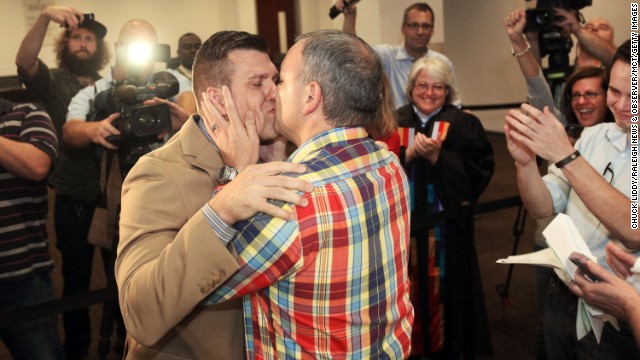 Chad Biggs, left, and his fiancé, Chris Creech, say their wedding vows at the Wake County Courthouse in Raleigh, North Carolina, on Friday, October 10, after a federal judge ruled that same-sex marriage can begin there.
Chad Biggs, left, and his fiancé, Chris Creech, say their wedding vows at the Wake County Courthouse in Raleigh, North Carolina, on Friday, October 10, after a federal judge ruled that same-sex marriage can begin there. 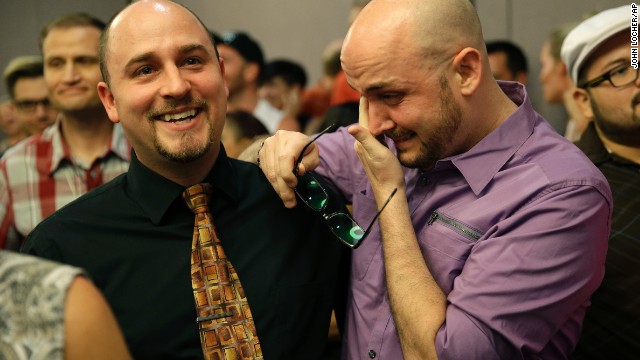 Joshua Gunter, right, and Bryan Shields attend a rally in Las Vegas to celebrate an appeals court ruling that overturned Nevada's same-sex marriage ban on Tuesday, October 7.
Joshua Gunter, right, and Bryan Shields attend a rally in Las Vegas to celebrate an appeals court ruling that overturned Nevada's same-sex marriage ban on Tuesday, October 7. 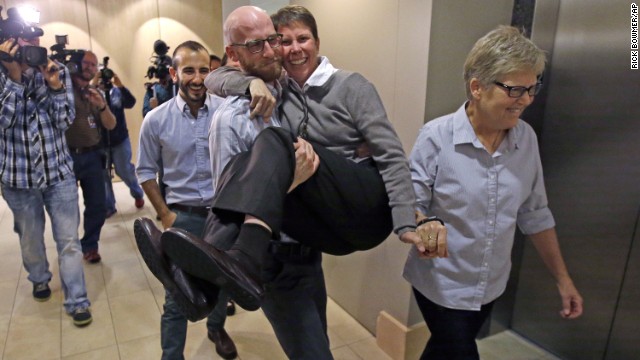 From left, plaintiffs Moudi Sbeity; his partner, Derek Kitchen; Kody Partridge; and Partridge's wife, Laurie Wood, celebrate after a news conference in Salt Lake City on Monday, October 6. The U.S. Supreme Court cleared the way Monday for legal same-sex marriages in five more states -- Virginia, Utah, Nevada, Indiana and Wisconsin.
From left, plaintiffs Moudi Sbeity; his partner, Derek Kitchen; Kody Partridge; and Partridge's wife, Laurie Wood, celebrate after a news conference in Salt Lake City on Monday, October 6. The U.S. Supreme Court cleared the way Monday for legal same-sex marriages in five more states -- Virginia, Utah, Nevada, Indiana and Wisconsin. 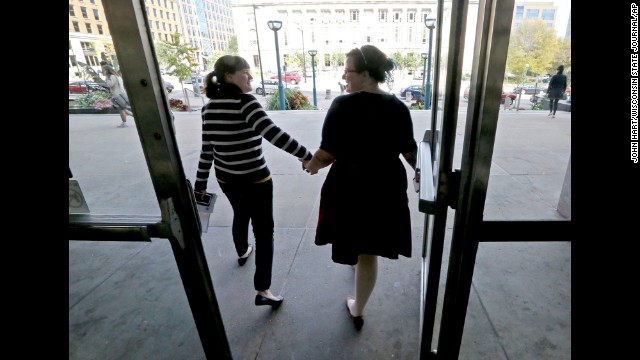 Abbi Huber, left, and Talia Frolkis exit the City County Building in Madison, Wisconsin, after applying for a marriage license on October 6.
Abbi Huber, left, and Talia Frolkis exit the City County Building in Madison, Wisconsin, after applying for a marriage license on October 6.  Rob MacPherson, right, and his husband, Steven Stolen, hug during a news conference at the American Civil Liberties Union in Indianapolis on October 6.
Rob MacPherson, right, and his husband, Steven Stolen, hug during a news conference at the American Civil Liberties Union in Indianapolis on October 6. 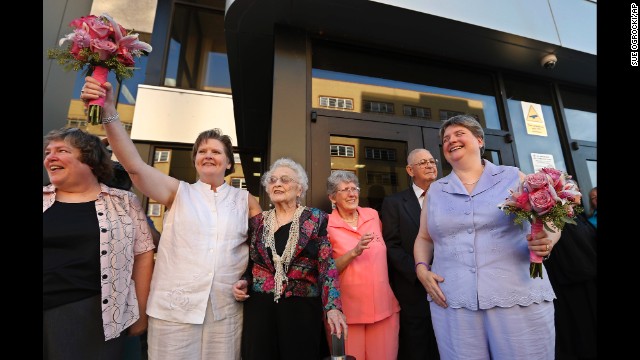 Mary Bishop, second from left, and Sharon Baldwin, right, celebrate with family and friends following their wedding ceremony on the courthouse steps in Tulsa, Oklahoma, on October 6.
Mary Bishop, second from left, and Sharon Baldwin, right, celebrate with family and friends following their wedding ceremony on the courthouse steps in Tulsa, Oklahoma, on October 6.  Jennifer Melsop, left, and Erika Turner kiss after they were married in front of the Arlington County Courthouse in Arlington, Virginia, on October 6.
Jennifer Melsop, left, and Erika Turner kiss after they were married in front of the Arlington County Courthouse in Arlington, Virginia, on October 6. 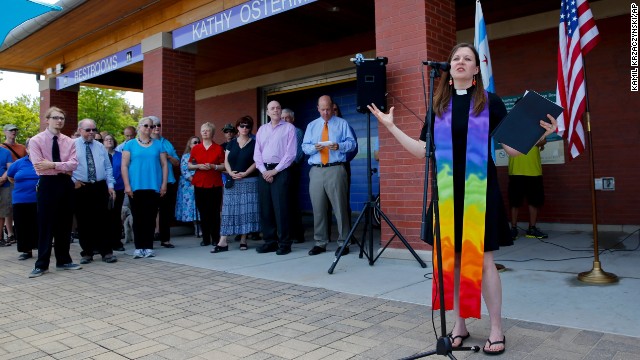 Pastor Carol Hill from Epworth United Methodist Church speaks during a marriage-equality ceremony at the Kathy Osterman Beach in Chicago on Sunday, June 1. June 1 marked the first day that all of Illinois' 102 counties could begin issuing marriage licenses to same-sex couples.
Pastor Carol Hill from Epworth United Methodist Church speaks during a marriage-equality ceremony at the Kathy Osterman Beach in Chicago on Sunday, June 1. June 1 marked the first day that all of Illinois' 102 counties could begin issuing marriage licenses to same-sex couples.  William Roletter, left, and Paul Rowe, right, press close to each other after having their photo taken with their newly acquired marriage certificate Wednesday, May 21, at City Hall in Philadelphia.
William Roletter, left, and Paul Rowe, right, press close to each other after having their photo taken with their newly acquired marriage certificate Wednesday, May 21, at City Hall in Philadelphia. 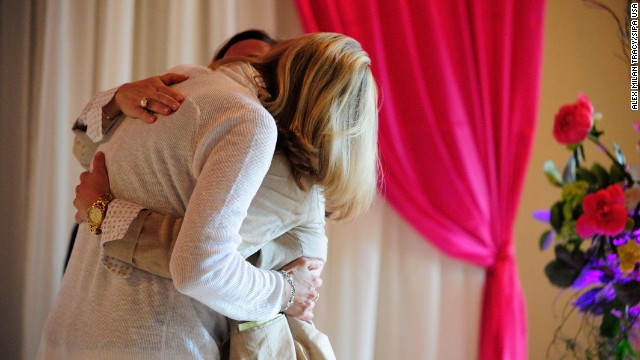 Julie Engbloom, left, and Laurie Brown embrace after they were wed in Portland, Oregon, on Monday, May 19. A federal judge struck down the state's voter-approved ban on same-sex marriage.
Julie Engbloom, left, and Laurie Brown embrace after they were wed in Portland, Oregon, on Monday, May 19. A federal judge struck down the state's voter-approved ban on same-sex marriage. 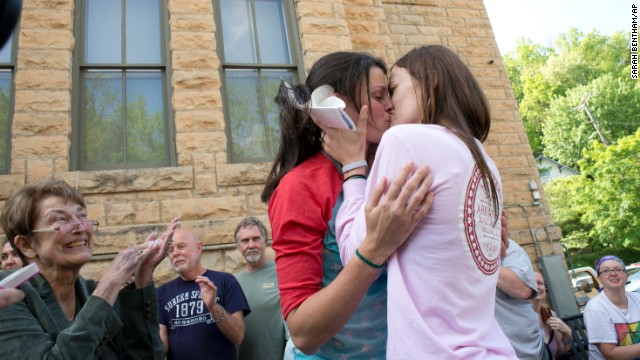 Jennifer Rambo, right, kisses her partner, Kristin Seaton, after their marriage ceremony in front of the Carroll County Courthouse in Eureka Springs, Arkansas, on Saturday, May 10. Rambo and Seaton were the first same-sex couple to be granted a marriage license in Eureka Springs after a judge overturned Amendment 83, which banned same-sex marriage in Arkansas.
Jennifer Rambo, right, kisses her partner, Kristin Seaton, after their marriage ceremony in front of the Carroll County Courthouse in Eureka Springs, Arkansas, on Saturday, May 10. Rambo and Seaton were the first same-sex couple to be granted a marriage license in Eureka Springs after a judge overturned Amendment 83, which banned same-sex marriage in Arkansas. 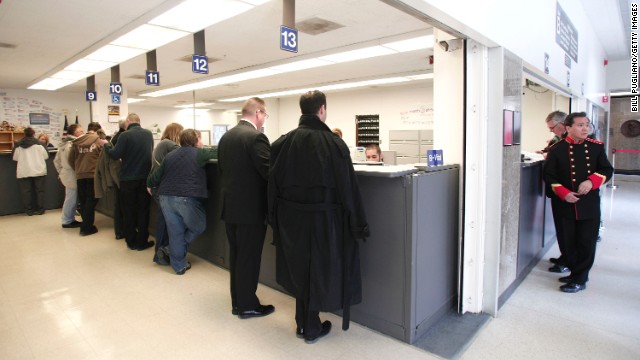 Same-sex couples get their marriage licenses at the Oakland County Courthouse in Pontiac, Michigan, on Saturday, March 22, a day after a federal judge overturned Michigan's ban on same-sex marriage.
Same-sex couples get their marriage licenses at the Oakland County Courthouse in Pontiac, Michigan, on Saturday, March 22, a day after a federal judge overturned Michigan's ban on same-sex marriage. 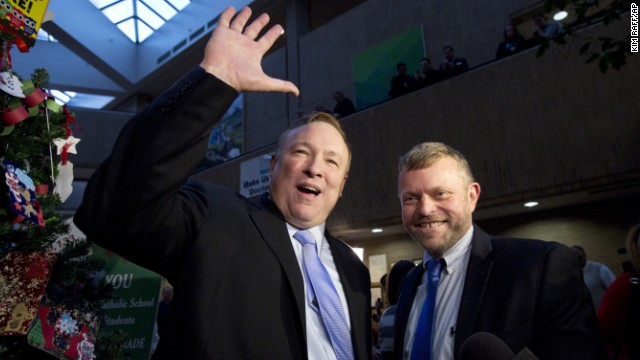 Utah state Sen. Jim Dabakis, left, and Stephen Justesen acknowledge the crowd after being married in Salt Lake City on Friday, December 20. A federal judge struck down Utah's ban on same-sex marriage, saying it conflicted with the constitutional guarantees of equal protection and due process. Many Utah counties began issuing marriage licenses before the state appealed to the U.S. Supreme Court. The high court temporarily blocked enforcement of the lower court ruling until the constitutional questions were fully resolved.
Utah state Sen. Jim Dabakis, left, and Stephen Justesen acknowledge the crowd after being married in Salt Lake City on Friday, December 20. A federal judge struck down Utah's ban on same-sex marriage, saying it conflicted with the constitutional guarantees of equal protection and due process. Many Utah counties began issuing marriage licenses before the state appealed to the U.S. Supreme Court. The high court temporarily blocked enforcement of the lower court ruling until the constitutional questions were fully resolved.  Plaintiffs Laurie Wood, left, and Kody Partridge, center, walk with attorney Peggy Tomsic on Wednesday, December 4, after a judge heard arguments challenging Utah's same-sex marriage ban.
Plaintiffs Laurie Wood, left, and Kody Partridge, center, walk with attorney Peggy Tomsic on Wednesday, December 4, after a judge heard arguments challenging Utah's same-sex marriage ban. 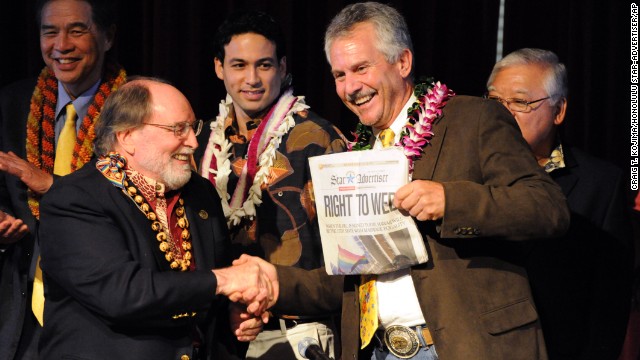 Hawaiian Gov. Neil Abercrombie, left, and former Sen. Avery Chumbley celebrate with a copy of the Star-Advertiser after Abercrombie signed a bill legalizing same-sex marriage in Hawaii on Wednesday, November 13.
Hawaiian Gov. Neil Abercrombie, left, and former Sen. Avery Chumbley celebrate with a copy of the Star-Advertiser after Abercrombie signed a bill legalizing same-sex marriage in Hawaii on Wednesday, November 13. 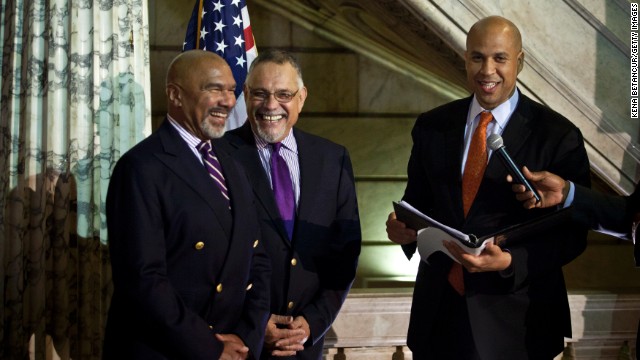 Newark, New Jersey, Mayor Cory Booker officiates a wedding ceremony for Joseph Panessidi and Orville Bell at City Hall in October 2013. The state Supreme Court denied the state's request to prevent same-sex marriages temporarily, clearing the way for same-sex couples to marry.
Newark, New Jersey, Mayor Cory Booker officiates a wedding ceremony for Joseph Panessidi and Orville Bell at City Hall in October 2013. The state Supreme Court denied the state's request to prevent same-sex marriages temporarily, clearing the way for same-sex couples to marry.  A couple celebrates at San Francisco City Hall upon hearing about the U.S. Supreme Court rulings on same-sex marriage in June 2013. The high court cleared the way for same-sex couples in California to resume marrying after dismissing an appeal on Proposition 8 on jurisdictional grounds. The court also struck down a key part of the Defense of Marriage Act, a 1996 federal law defining marriage as between a man and a woman.
A couple celebrates at San Francisco City Hall upon hearing about the U.S. Supreme Court rulings on same-sex marriage in June 2013. The high court cleared the way for same-sex couples in California to resume marrying after dismissing an appeal on Proposition 8 on jurisdictional grounds. The court also struck down a key part of the Defense of Marriage Act, a 1996 federal law defining marriage as between a man and a woman. 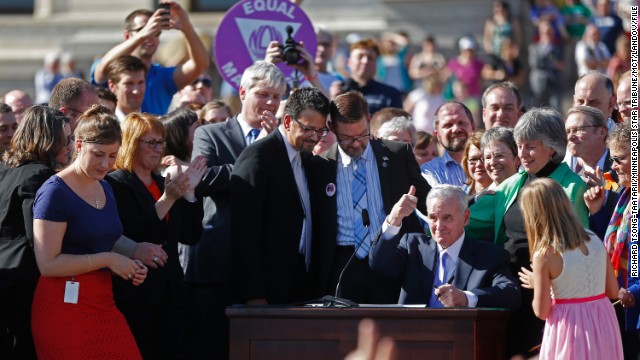 At the state Capitol in St. Paul, Minnesota, Gov. Mark Dayton signs a bill legalizing same-sex marriage in May 2013.
At the state Capitol in St. Paul, Minnesota, Gov. Mark Dayton signs a bill legalizing same-sex marriage in May 2013.  Delaware Gov. Jack Markell holds up legislation in May 2013 allowing same-sex couples to wed in the state.
Delaware Gov. Jack Markell holds up legislation in May 2013 allowing same-sex couples to wed in the state. 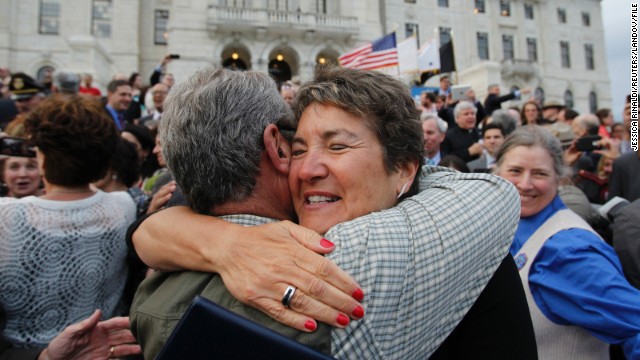 Rhode Island state Sen. Donna Nesselbush, right, embraces a supporter after the Marriage Equality Act was signed into law at the statehouse in Providence in May 2013.
Rhode Island state Sen. Donna Nesselbush, right, embraces a supporter after the Marriage Equality Act was signed into law at the statehouse in Providence in May 2013. 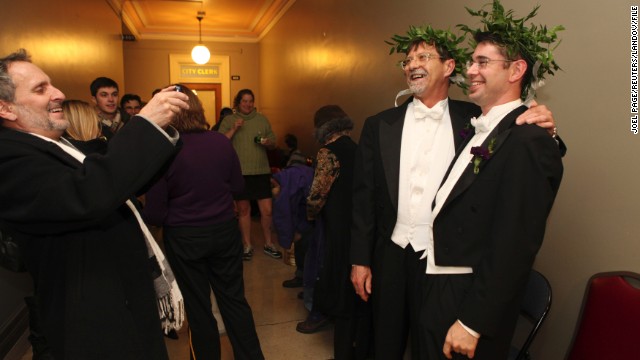 Jamous Lizotte, right, and Steven Jones pose for photos while waiting for a marriage license in Portland, Maine, in December 2012.
Jamous Lizotte, right, and Steven Jones pose for photos while waiting for a marriage license in Portland, Maine, in December 2012. 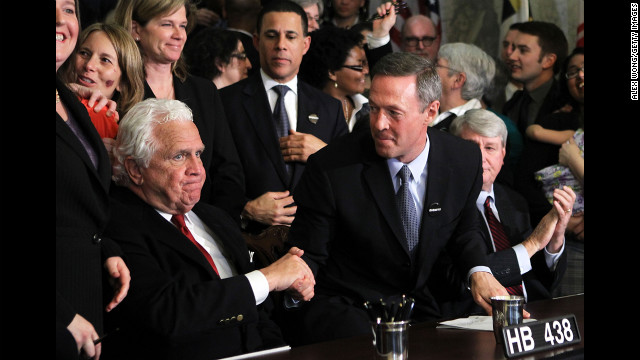 Maryland Gov. Martin O'Malley, center, shakes hands with Senate President Thomas V. "Mike" Miller after signing a same-sex marriage bill in March 2012. The law was challenged, but voters approved marriage equality in a November 2012 referendum.
Maryland Gov. Martin O'Malley, center, shakes hands with Senate President Thomas V. "Mike" Miller after signing a same-sex marriage bill in March 2012. The law was challenged, but voters approved marriage equality in a November 2012 referendum. 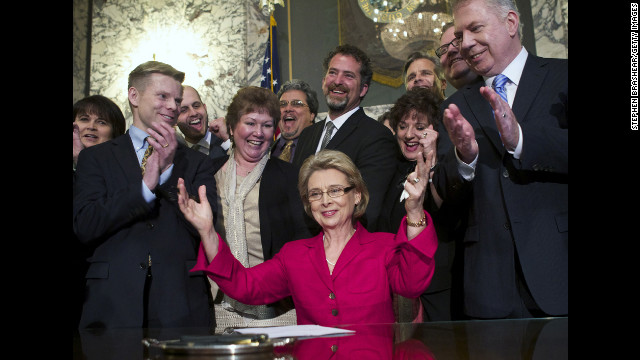 Washington Gov. Chris Gregoire celebrates after signing marriage-equality legislation into law on February 13, 2012. Voters there approved same-sex marriage in November 2012.
Washington Gov. Chris Gregoire celebrates after signing marriage-equality legislation into law on February 13, 2012. Voters there approved same-sex marriage in November 2012.  Phyllis Siegel, right, kisses her wife, Connie Kopelov, after exchanging vows at the Manhattan City Clerk's office on July 24, 2011, the first day New York's Marriage Equality Act went into effect.
Phyllis Siegel, right, kisses her wife, Connie Kopelov, after exchanging vows at the Manhattan City Clerk's office on July 24, 2011, the first day New York's Marriage Equality Act went into effect. 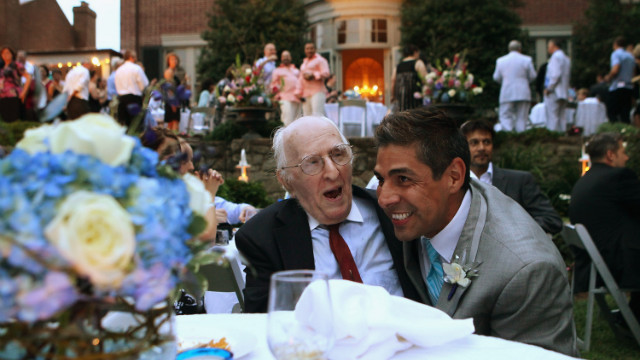 In 2010, television reporter Roby Chavez, right, shares a moment with gay rights activist Frank Kameny during Chavez and Chris Roe's wedding ceremony in the nation's capital. Same-sex marriage became legal in Washington in March 2010.
In 2010, television reporter Roby Chavez, right, shares a moment with gay rights activist Frank Kameny during Chavez and Chris Roe's wedding ceremony in the nation's capital. Same-sex marriage became legal in Washington in March 2010. 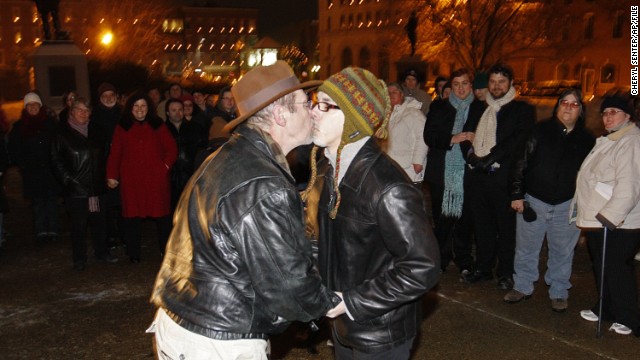 Olin Burkhart, left, and Carl Burkhart kiss on the steps of the New Hampshire Capitol in January 2010 after the state's law allowing same-sex marriage went into effect.
Olin Burkhart, left, and Carl Burkhart kiss on the steps of the New Hampshire Capitol in January 2010 after the state's law allowing same-sex marriage went into effect. 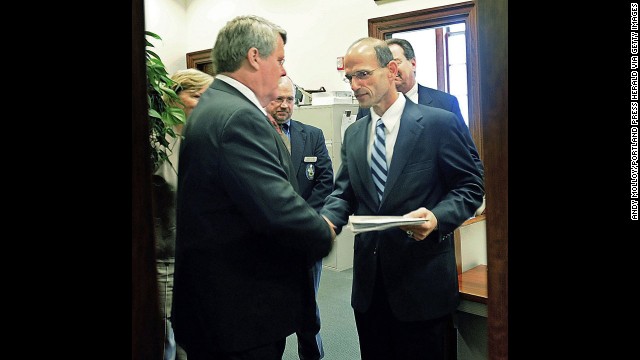 Maine state Sen. Dennis Damon, left, hands Gov. John Baldacci the bill that the state Senate passed in May 2009 to affirm the right of same-sex couples to marry.
Maine state Sen. Dennis Damon, left, hands Gov. John Baldacci the bill that the state Senate passed in May 2009 to affirm the right of same-sex couples to marry. 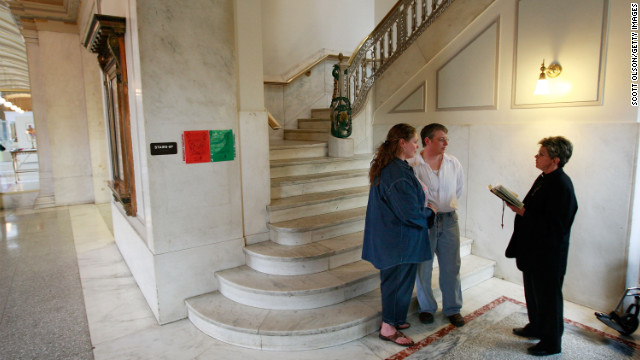 Amy Klein-Matheny, left, and her wife, Jennifer, exchange vows in Iowa after same-sex couples were allowed to marry there with a court ruling in April 2009.
Amy Klein-Matheny, left, and her wife, Jennifer, exchange vows in Iowa after same-sex couples were allowed to marry there with a court ruling in April 2009.  Michael Miller, left, and Ross Zachs marry on the West Hartford Town Hall steps after same-sex marriages became legal in Connecticut on November 12, 2008.
Michael Miller, left, and Ross Zachs marry on the West Hartford Town Hall steps after same-sex marriages became legal in Connecticut on November 12, 2008.  Lara Ramsey, left, and her partner of eight years, Jane Lohmann, play with their 7-month-old son, Wyatt Ramsey-Lohmann. The two wed in 2004 after Massachusetts approved same-sex marriage. Massachusetts was the first state to do so.
Lara Ramsey, left, and her partner of eight years, Jane Lohmann, play with their 7-month-old son, Wyatt Ramsey-Lohmann. The two wed in 2004 after Massachusetts approved same-sex marriage. Massachusetts was the first state to do so.
- Stephanie Coontz: Since first same-sex marriage state, U.S. attitudes have changed fast
- Number of Americans living where gay marriage legal will likely soon reach 60%, she says
- Coontz: More high profile gays in culture; plus civil rights, feminism widened view on social equality
- Coontz: Big shifts in concept of equality in heterosexual marriage also helped clear path
Editor's note: Stephanie Coontz teaches at The Evergreen State College in Olympia, Washington, and is director of research and public education at the Council on Contemporary Families. She is the author of "Marriage, a History: How Love Conquered Marriage."
(CNN) -- In 2003, Massachusetts became the first state to legalize same-sex marriage. At that time, 60% of Americans opposed the idea and the move provoked an immediate backlash. In the next year, 12 states passed constitutional amendments outlawing same-sex marriage. Eventually 30 states, including traditionally liberal California, passed such measures.
But since then there has been an astounding transformation of public opinion and legal thinking. Support for gay and lesbian civil rights, starting from a much lower base than support for racial and gender equality, has risen with stunning speed. Between 2003 and 2013, the proportion of Americans supporting same-sex marriage rose 21 points nationwide, from 32% to 53%, writes Robert P. Jones in The Atlantic.
Even in the socially conservative South, support more than doubled, increasing from 22% to 48%. By contrast, in 1978, 11 years after the Supreme Court struck down laws prohibiting interracial marriage, only 36% of Americans supported such unions.
This rapid and massive change in public attitudes toward same-sex marriage undercuts the argument that "judicial activism" has frustrated the will of the American people. But the legal tide has certainly turned as well. In the past year and a half, 42 separate court rulings have upheld marriage rights for gays and lesbians.
Because of this month's Supreme Court decision not to hear appeals of such rulings, 24 states and the District of Columbia now permit same-sex marriage. Today more than 50% of Americans live in places where it is legal for gays and lesbians to wed. That will soon rise to 60%, because the Supreme Court's actions affect six other states in the judicial circuits overseen by the same appellate courts.
Many factors have contributed to these changes in public and legal opinion. One is the increased visibility of gays and lesbians across the culture, as more come out of the closet. Three-quarters of Americans now say they have a relative, friend or co-worker who is gay and millions have become used to sympathetic gay and lesbian characters on television and to openly gay talk-show hosts and entertainers. It is harder to deny rights to people who are no longer faceless "others."
Another factor in the rapid acceptance of marriage equality is the success the civil rights and feminist movements have had in establishing social equality as a moral and ethical principle. Fifty years ago, when the Civil Rights Bill was introduced in Congress, congressional opponents openly vowed to resist anything that might "bring about social equality."
No public figure would say that today. Even politicians who oppose measures to protect the rights of minorities, women or gays and lesbians now frame their opposition as a defense of equality against "special privileges." So when advocates for social change can claim their goal is a simple matter of equity, they have an advantage they lacked in the 1960s and even the 1970s, when substantial numbers of Americans were still willing to admit to opposing gender and racial equality.
 High court puts hold on same-sex cases
High court puts hold on same-sex cases  Nevada senator's joyous proposal
Nevada senator's joyous proposal  Supreme Court rejects same-sex cases
Supreme Court rejects same-sex cases  SCOTUS: Same-sex marriage, speech, beards
SCOTUS: Same-sex marriage, speech, beards A third factor behind changing public opinion has been the growing tendency to treat freedom of choice in marriage as a basic right. This was not the case historically. Before the late 1960s, a majority of states had laws prohibiting marriage of whites to blacks, Asians or Filipinos.
Twelve states forbade "drunks" or "mental defectives" from marrying. Several states denied marriage to any person with tuberculosis. Prisoners had no right to marry, and employers were legally entitled to refuse to hire a woman who was married, or to fire her if she married after getting the job.
But in 1967, invalidating anti-miscegenation laws, and in 1987, ruling that prisoners could not be denied marriage rights, the Supreme Court ruled that states could not prohibit marriages just because they disapproved of the partnership. Once it became a violation of individual rights to prevent prisoners, inter-racial couples, flight attendants, and female teachers from marrying, gays and lesbians could argue that they, too, should have the right to marry a partner of their choice.
Ironically, the most important factor in persuading many Americans to support same-sex marriage may have been the dramatic changes heterosexuals have made in their own marriages.
For thousands of years, marriage was defined as the union of two individuals who had different and unequal rights and responsibilities based on their gender.
Until the late 1970s, husbands -- but not wives -- were legally obliged to support their families, while wives -- but not husbands -- were legally obliged to perform services (including providing sex) in the home. This is why the legal definition of rape was a man's forcible intercourse with a woman not his wife. It is also why a husband could sue for the loss of companionship, affection and sex (when the actions of another deprived him of the relationship benefits he was due), but a wife, who was not legally entitled to such services, could not.
In the past 30 years, however, as Americans have rejected such rigid gender roles, the courts have redefined marriage as a union of two individuals who have equal rights and responsibilities, and who can organize their marital division of labor on the basis of personal inclinations rather than pre-assigned gender roles.
As late as 1977, two-thirds of Americans believed that the man should be "the achiever outside the home" and the woman should take "care of the home and family." Today 62% of all Americans prefer a marriage where husband and wife share breadwinning, child care, and homemaking. The more that heterosexual couples organize their own marriages without regard to gender roles, the less reasonable they find it to deny marriage to two people who happen to be the same biological sex.
Read CNNOpinion's new Flipboard magazine
Follow us on Twitter @CNNOpinion.
Join us on http://ift.tt/1bl3g0P.
No comments:
Post a Comment